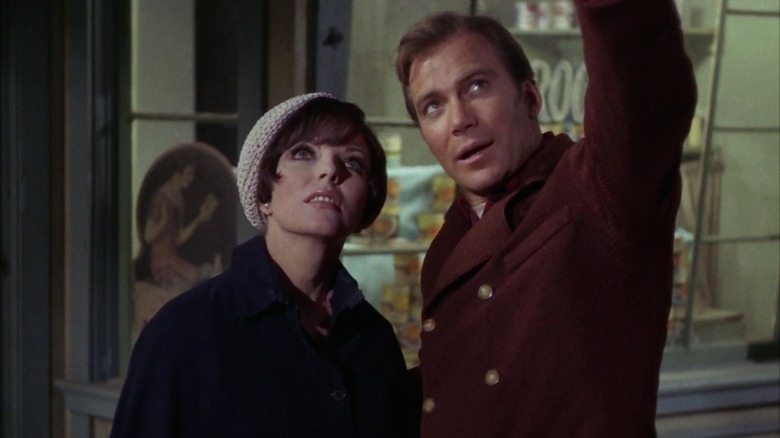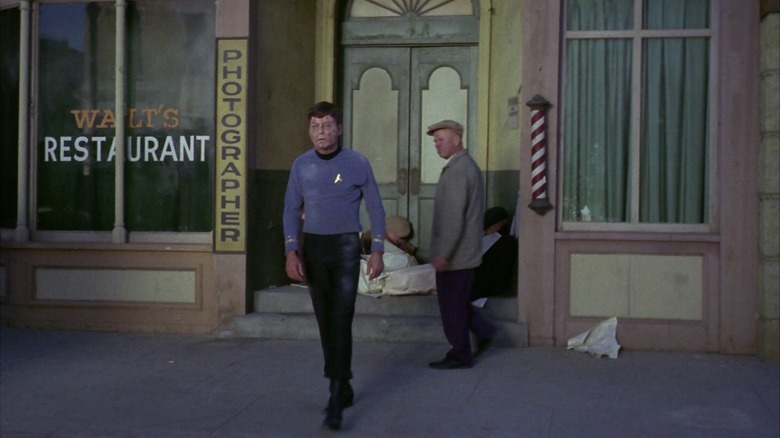An Episode Of Star Trek: TOS Shares A Connection With The Andy Griffith Show
"The City on the Edge of Forever" (April 6, 1967) is often considered the best episode of the series. In it, Captain Kirk (William Shatner) and Spock (Leonard Nimoy) encounter an impossibly ancient stone archway called the Guardian of Forever. The Guardian (Bartell LaRue) is so old it has developed consciousness and serves as a time travel conduit for curious historians. Unexpectedly, Dr. McCoy (DeForest Kelley) runs through the portal — he's hopped up on drugs — and travels instantly to Earth in 1930. Kirk and Spock follow him to ensure he doesn't foul with history.
In 1930, Kirk meets an activist named Edith Keeler (Joan Collins), a kindly soul who speaks out against the growing war efforts in Europe. Kirk falls in love. Spock, however, constructs a widget showing him that only two possible futures can come of their time travel interference. It seems that if Edith Keeler dies in a car accident, it will retain history and cause the Nazis to lose World War II. If she lives, the Nazis will win. Kirk has to make an ethical decision; does he rescue the woman he loves, or let her die in order to restore history? It's a great premise for a "Twilight Zone" episode.
If one should want to criticize "The City on the Edge of Forever," one might point out that Kirk could have simply brought Edith with him back to the future. That way, she would survive, and her disappearance in 1930 would have fulfilled the anti-Nazi timeline. In 2019, the legendary Joan Collins talked with StarTrek.com about working on the episode, and recalled having to report to the same soundstage where NBC shot "The Andy Griffith Show." Odd that a sci-fi series should also include shots of Floyd's Barbershop.
It's the Andy Griffith Show, starring ... Spock?
Filming of "The City on the Edge of Forever" was, as Trekkies might be able to tell you, a tangled affair. The episode cost $245,316, which was beyond the $191,000 allocated, as show creator Gene Roddenberry wanted high-quality sets. Several behind-the-scenes books about "Star Trek" note that the episode's director, Joseph Pevney, had to shoot at preestablished NBC studios. Pevney also didn't know if he'd have access to the sets once he left (other shows were scheduled in the space when he was done). As such, he just kept on shooting all day and into the night. This was also done to demonstrate to NBC that "Star Trek" was making efforts to save money.
Attentive viewers will indeed notice Floyd's Barbershop from "Andy Griffith" in a few shots. Collins didn't notice that "Star Trek" was doubling up. Her career was taking off at the time, and she had no reason to question where a show was shot or what other shows might be filmed there. She merely showed up with her lines memorized, then moved to the next gig. She, like most "Trek" guest actors, merely signed on for the job, giving no thought as to a show's potential historical significance. About the set, Collins said:
"I had no clue! As far as I was concerned, I was starting to do lots of television at that time. I did 'The Man from U.N.C.L.E.' I did 'The Virginian.' So I was doing quite a few shows and, as far as I was concerned, ['Star Trek'] really was just another gig."
Which is a diplomatic and expected view, coming from an actor. When asked what she thought of the completed episode, Collins merely replied "I don't watch my older work. I'm not Gloria Swanson."

